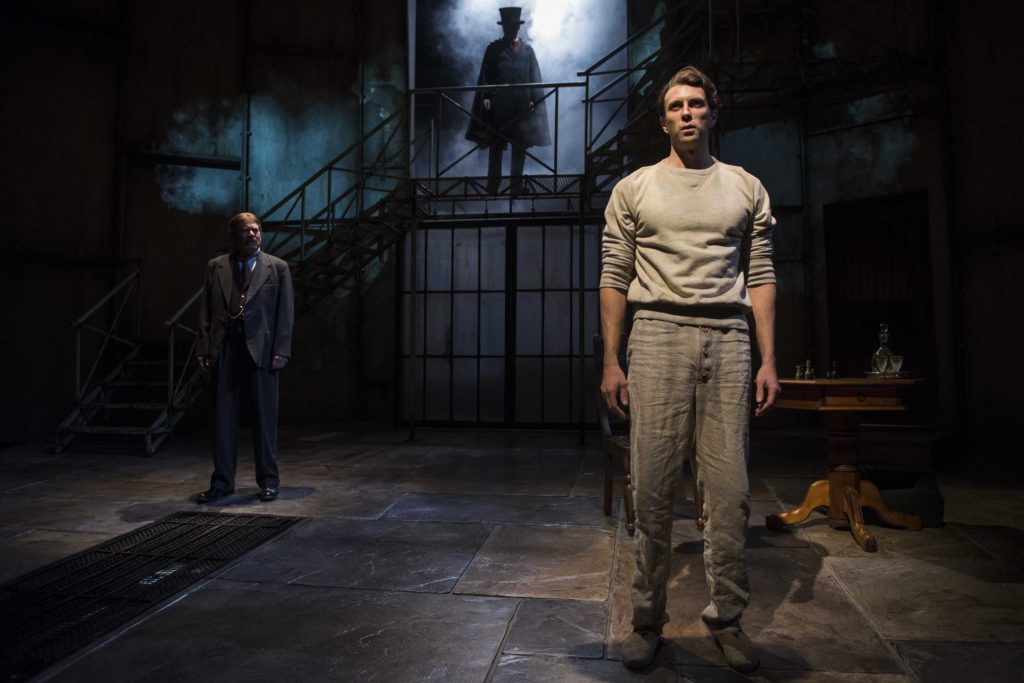
by Jeff Grygny
“When you have eliminated the impossible,” goes Sherlock Holmes’ famous aphorism, “whatever remains, however improbable, must be the truth.” Sounds simple enough—but when we confront the blooming chaos of life, sorting out all the possibilities (as Doctor Watson often found) is less like subtraction and more like fractal geometry, wherein a simple operation repeatedly performed generates baroque patterns of dizzying complexity.
Holmes and Watson, now in production at the Milwaukee Repertory Theatre, begins with a straightforward process of elimination: choose the real Sherlock Holmes out of three possible claimants. But it quickly goes fractal, like one of M. C. Escher’s space-bending engravings, where we feel lost in the borderlands between truth, lies, fiction, and the fictions we tell ourselves about other people, even— perhaps especially— our dearest friends. The question “Who is the real Sherlock Holmes?” takes on almost metaphysical dimensions.

This is only the second production of Jeffrey Hatcher’s play, but in this crisp, elegant production, it already seems destined to a place in the highest ranks of Sherlock Holmes adaptations. The moment you step off the ferry that transports Doctor John Watson to the ominous island sanatorium, you enter a hall of mirrors where appearances flaunt themselves as truth from every angle, only to be contradicted by other equally plausible claims. The mystery sets its teeth into you and never loosens its grip for the play’s entire 80 minute running time. As in the best of the genre, you match wits with the detective, trying to be a sharp as Holmes would be, noticing every small detail that might be the key to the puzzle. Aided immensely by the actors’ craft, the designers’ atmosphere, and the clockwork direction of Joseph Hanreddy, you’re doing headwork every minute, and the time flies by. It’s almost a pity there’s no intermission, as the lobby would without a doubt be buzzing with hypotheses.
This review will respect the playwright’s feeling that “It’s more fun not to know anything when the curtain rises.” Suffice to say, then, that the inmates tell different stories of the same event, which all seem equally credible and suspicious— complicated by the fact the Watson has made so many of Holmes’ adventures public record, making it easy for impostors (but how accurate are Watson’s stories, eh?). Not to mention that there are certain oddities and inconsistencies in almost every character’s words and/or actions. And when events reach out to the world beyond the island, things really get complicated. The plot’s construction can only be called masterful, and steeped in Holmesian lore—which is what you’d expect from an Edgar-winning writer who’s previously penned two Holmes stories for stage and screen.
Hatcher’s latest offering is, you might say, in the vein of British showrunner Steven Moffat’s Sherlock and Doctor Who: having thoroughly digested the canon and hungry for something fresh, opening with dazzling cleverness, following up with seemingly insoluble puzzles and bold dramatic gestures (appropriate to the claustrophobic setting), then quickly wrapping things up without over-much attention to the picky details. It’s a splashy, showy approach, well in the mood of today’s entertainment preferences—and that’s not a bad thing. There might be enough information for the astute viewer to solve the puzzle—but you don’t have to. The great pleasure of Holmes and Watson is to be led into an inescapable maze, encounter heroes, villains, and victims, and then to be safely escorted out again.

The impeccable cast delivers the content-heavy script with unstuffy precision. Though the Rep brings in top talent from around the country, it’s nice to see two local actors hold their own in the leading roles: Norman Moses, as Watson, brings a touch of theatrical flair to the solemn proceedings, while Mark Corkins, as the head doctor of the asylum, manages to always seem like he knows secrets he’s not letting us in on. The three actors playing the inmates give strong, distinct characterizations with shades of pathos and sizable portions of humor, all orchestrated by Hanreddy with economical use of each moment. Bill Clarke’s set is grand and austere, enlivened by projected images of sea travel by Mike Tutaj. When we see the monochrome waves rolling over the walls, we’re immediately transported to another place and time. Sound designers Rob Milburn and Michale Bodeen create another character in the well-timed punctuation of clanging doors, reverberating bangs, and the clicks of keys in locks.
Sherlock Holmes is a 20th Century archetype: the man of pure reason. His sagas of crime and justice reflect the deep structure of the modern world—which is why he continues to fascinate us. Holmes and Watson is an admirable addition to the mythos. But more importantly, it’s a ripping good story. And if the outcome seems a tad improbable—well, it was the only possible solution.
Milwaukee Repertory Theater presents
Holmes and Watson
by Jeffrey Hatcher
directed by Joseph Hanreddy
playing through December 17
